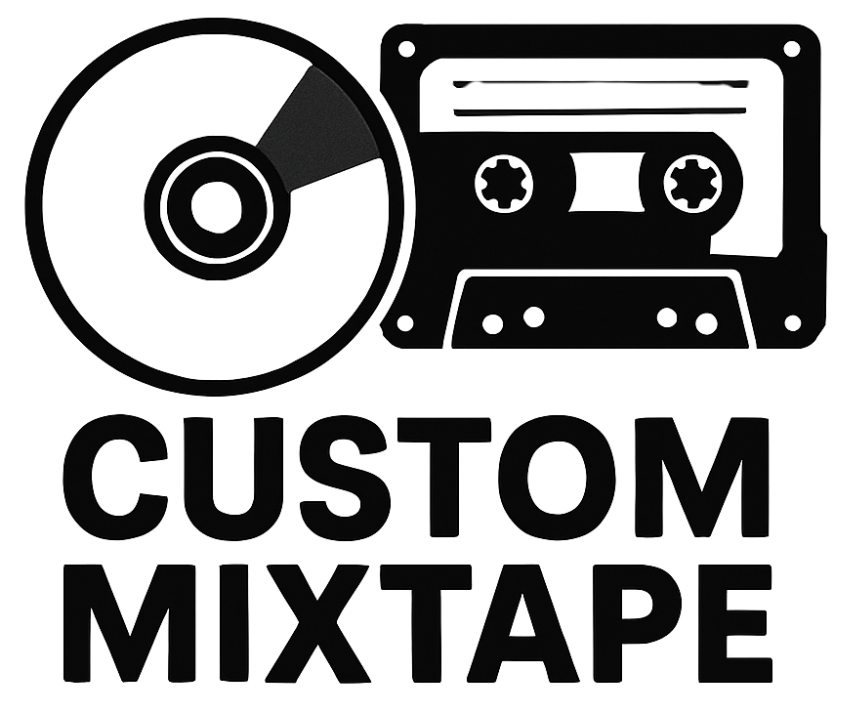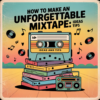Why Cassettes Are Back — and More Meaningful Than Ever
Cassette Comeback: Why It’s Trending Again
Maybe it’s the sound. Maybe it’s the click. Or maybe it’s the feeling of holding something real, something made just for you. Cassettes are back — and it’s not just nostalgia. It’s connection, it’s story, it’s personal. Let’s explore why this analog gem is trending again.
Cassette tapes, once thought to be a technology of the past, are making a comeback in popular culture. This trend is particularly evident with chart-topping artists such as Billie Eilish and Taylor Swift releasing their music on the retro format. While the reasons for this resurgence may vary, one thing is certain: cassettes are trending again. Let’s take a closer look at why.
Nostalgia Fuels the Revival
It’s a unique twist in the narrative of music evolution that cassette tapes, widely considered an outdated medium for listening to music, are making a triumphant return in popular culture. The resurgence of cassette tapes, often dubbed the “cassette comeback,” can be attributed to a multitude of factors, with nostalgia being a primary driver. In an era dominated by digital music and an abundance of streaming services, there is a certain charm and warmth associated with the analog sound of cassette tapes that resonates with both the young and the old, evoking a profound sense of nostalgia. This revival in cassette culture has been fueled by the growing interest of music enthusiasts, independent artists, and mainstream acts alike, who are embracing the unique listening experience offered by cassette tapes, and it reflects a significant shift in the way people perceive and interact with music.
One cannot discuss the cassette tape revival without acknowledging the influential role of iconic artists in this unexpected trend. The resurgence of cassette tapes has been significantly propelled by the likes of Billie Eilish, Taylor Swift, and other mainstream acts who have not only expressed their preference for the format but have also taken bold steps in releasing their new music on cassettes. As a result, the sound of cassette tapes, once relegated to the annals of music history, is now echoing through the speakers of enthusiasts and casual listeners alike, paving the way for a remarkable revival that is reminiscent of the cassette era in the 1980s and 1990s. The passionate advocacy and active participation of these top-tier artists have undeniably been a driving force in propelling the cassette comeback, reintroducing the charm of magnetic tapes to a new generation of music lovers while rekindling the pristine memories of the past for many. It’s a testament to the enduring allure of a bygone musical era and the influential power of nostalgia in shaping the trends of the contemporary music landscape.
Convenience and Affordability
A significant driver behind the rejuvenation of cassette tapes is their practicality and affordability, which set them apart from other formats such as vinyl records and CDs. In a time when the digital music realm is saturated with an abundance of platforms and devices, the recalibrated appeal of cassette tapes lies in their simplicity and ease of use. The compact nature of cassette players and their cost-effective nature make them an attractive option for music aficionados and independent artists seeking a more economical yet enriching medium for enjoying and releasing music. Furthermore, the tactile nature of cassette tapes and the intrinsic hands-on experience they offer provide a welcome departure from the impersonal nature of digital music, making them an appealing choice for a growing segment of music enthusiasts who value a more intimate and tangible connection to their favorite tunes. This revival, based on a newfound appreciation for the cassette as a portable and user-friendly format for music consumption, is indeed a testament to the evolving dynamics of the music industry and the ever-changing preferences of music enthusiasts.
Amid discussions about the evolving landscape of music consumption, one cannot overlook the significance of the affordability and accessibility offered by cassette tapes, which, in many ways, position them as a timeless and cost-effective medium for both music lovers and emerging independent artists. In an era when the cost of music production and distribution continues to pose challenges, cassette tapes present a viable and alluring alternative due to their relatively lower manufacturing costs, ultimately democratizing the process of releasing and consuming music. Playlist and mixtape enthusiasts, as well as emerging musicians, find a strategic advantage in the economic appeal of cassette tapes, making them a compelling choice for individuals and acts at various stages of their musical journey. The practical and budget-friendly nature of cassette tapes serves as a driving force in the ongoing revival, solidifying their position as a formidable player in the contemporary music landscape.
The Tactile Experience
Heartfelt nostalgia and a renewed appreciation for the tactile and analog experience have propelled cassette tapes to the forefront of the audio industry. Unlike digital music, which can be easily accessed and navigated with the simple click of a button, cassette tapes offer a more immersive and analog listening experience that cannot be replicated by other formats. The act of fast-forwarding or rewinding a cassette, the anticipation of a new mixtape, and the interactive nature of manually selecting tracks are all elements that contribute to a truly one-of-a-kind listening experience. For music enthusiasts and collectors, the tangible and historic aspects of cassette tapes evoke a sense of intimacy and authenticity that is increasingly sought after in a digital-driven music landscape. The tactile experience provided by cassette tapes, with their distinct clicks and whirs, pays homage to a more personal and hands-on way of enjoying music, and this significant appeal has played a pivotal role in their ongoing revival in popular culture, enriching the listening experience in a way that transcends the limitations of digital formats.
Embracing the cassette culture also means reviving a cherished tradition of creating and sharing “mixtapes,” which hold a deeply sentimental value for many music enthusiasts. The art of carefully curating and thoughtfully sequencing the tracks on a mixtape is an evocative and momentous practice that has been enduringly cherished, and the cassette format perfectly encapsulates the timeless nature of this art. The Advent of portable cassette players further enhances the affection for mixtapes, making them an attractive and nostalgic option for music lovers on the go. As such, the revival of cassette tapes not only reintroduces a beloved music format but also reignites the timeless tradition of crafting and exchanging mixtapes, thereby preserving and perpetuating a cherished custom that is emblematic of an authentic and heartfelt approach to music appreciation.
Sound Quality Debates
At the heart of the cassette tape revival are fervent debates surrounding the sound quality of cassettes in comparison to other formats, particularly the dominant digital mediums. While digital music is often lauded for its precision and pristine audio quality, the distinct and, at times, imperfect allure of cassette tapes speaks to a more emotive and nostalgic listening experience. The analog warmth and inherent imperfections of cassette tapes, characterized by subtle fluctuations and the captivating “wow and flutter,” contribute to a uniquely textured sound that resonates with a certain segment of music enthusiasts and audiophiles. These distinguishing auditory characteristics not only evoke a sense of nostalgia but also offer a more human and organic quality to the listening experience, which, for many, surpasses the clinical perfection of digital formats. As a result, the ongoing debate over the sound quality of cassettes continues to be a compelling factor in the revival, attracting a dedicated and impassioned cohort of music lovers who firmly champion the distinctive and irreplaceable sound signature of cassette tapes.
Amid the debates surrounding the sound quality of cassette tapes, it is worth noting that the resurgence of CDs in recent years also points to a parallel and compelling discussion within the audio industry. Just as cassette tapes are experiencing a revival due to their favorable qualities and resonances, CDs have garnered renewed attention and appreciation, as their affordability and capacity for lossless audio make them a viable and enriching option for consumers. The evolving dynamics of musical formats and the ongoing discourse on sound quality reflect the ever-shifting landscape of audio consumption and the diverse preferences of music enthusiasts, ultimately shaping the trends and preferences that define the contemporary audio industry. The coexistence of cassette tapes, CDs, and digital formats demonstrates the multifaceted and nuanced dynamics of the modern-era music industry, where the past, present, and future converge in the fascinating and dynamic realm of audio consumption and dissemination.
CDs Also Making a Comeback
Interestingly, amid the resurgence of cassette tapes, CDs are also making a significant comeback, thanks to their inherent affordability and capacity for storing lossless audio. In a landscape increasingly dominated by digital music and an array of streaming services, the distinctive physical presence and archival value of CDs have sparked a renewed interest among music enthusiasts, particularly due to their ability to encapsulate and preserve timeless musical creations in a tangible and durable format. The past decade has witnessed a notable upswing in CD production and consumption, with many independent artists and established acts embracing the medium as a primary vehicle for releasing their music to the world. Furthermore, the accessibility and cost-effectiveness of CDs have made them an alluring and practical choice for both music lovers and emerging artists seeking a reliable and durable format for sharing their sonic artistry. The sustained resurgence of CD culture, in tandem with the revitalization of cassette tapes, underscores the intricate and intricate interplay of various audio formats and the dynamic and expansive landscape of the contemporary music industry.
It is worth noting that the resurgence of cassette tapes and the revitalization of CD culture are not mutually exclusive, as both mediums offer a unique and enduring appeal that aligns with the diverse preferences and values of music enthusiasts. While cassette tapes exude a distinct and evocative charm rooted in nostalgia and analog warmth, CDs stand as a bastion of physical ownership and archival permanence, resonating with a different set of sentiments and priorities. The ongoing discourse and evolution surrounding the cassette comeback and the CD renaissance encapsulate the rich and complex tapestry of the modern music landscape, where the past, present, and future converge in a symphony of enduring and evolving audio formats and experiences. Ultimately, the revival of cassette tapes, CDs, and the ongoing discussions surrounding sound quality and audio nostalgia collectively reflect the diverse and dynamic landscape of the audio industry, where a multifaceted array of audio formats coexist and interplay to shape the trends and preferences that define the contemporary musical zeitgeist.
Accessing Lossless Audio
Amid the ongoing debates surrounding sound quality and the revival of cassette tapes and CDs, it is essential to acknowledge the profound significance of accessing lossless audio, which serves as a compelling and consequential factor in shaping the contemporary audio landscape. While the digital realm continues to exhibit a predominant focus on the accessibility and convenience of digital music, there is a concurrent and substantial appreciation for the archival and fidelity-oriented nature of lossless audio formats, including CDs and, to a certain extent, cassette tapes. The ability to access and engage with lossless audio, characterized by its uncompromising fidelity and pristine sonic nuances, stands as a hallmark of audio refinement and sophistication, catering to a discerning and discerning audience of music enthusiasts and audiophiles who prioritize the unparalleled and unyielding qualities of sonic fidelity and clarity. This evergreen and timeless pursuit of uncompromised sound reproduction and audio excellence resonates deeply with a significant segment of the global audio community, further substantiating the enduring allure and relevance of lossless audio formats in shaping the present and future paradigms of audio consumption and appreciation.
The quest for uncompromised sound reproduction and the profound and introspective appreciation of lossless audio reverberates with a global audience of music enthusiasts, serving as a testament to the enduring and timeless values of sonic fidelity and audio excellence. The enduring relevance and contemporaneity of lossless audio formats, including CDs and, to a modest extent, cassette tapes, underscore the enduring and evergreen resonance of archival and fidelity-oriented audio mediums in shaping the present and future paradigms of audio consumption and appreciation. As the contemporary audio landscape continues to evolve and stratify, it is the timeless and enduring appeal of lossless audio formats that holds the potential to shape and redefine the sonic experiences of music enthusiasts and discerning listeners, perpetuating the eternal and perennial allure of uncompromised sonic fidelity and unyielding audio excellence in the dynamic and multifaceted realm of the audio industry.
Revisiting the Cassette Debate
Amidst the ongoing tapestry of music evolution and the unfolding dynamics of the audio industry, the phenomenon of the cassette comeback stands as a paragon of the multifaceted and nuanced nature of contemporary audio consumption and dissemination. The enduring and evolving discussions surrounding the cassette revival and the intricate interplay of various audio formats and experiences serve as a poignant and insightful reflection of the diverse and evolving landscape of the audio industry. As the cassette resurrection continues to resonate with a burgeoning audience of music enthusiasts and top-tier artists alike, it beckons a profound and introspective exploration of the intricate motivations and compelling drivers that underpin the resurgence of cassette tapes, ultimately offering a compelling and multifaceted narrative that transcends the simplicity of musical formats and delves into the complex and captivating realm of musical appreciation, nostalgia, and the enduring evolution of sonic experiences.
The enduring fascination and deeply rooted nostalgia associated with cassette tapes, coupled with the practical and accessible nature of the format, have not only catalyzed the ongoing resurgence but have also precipitated profound and introspective discussions that delve into the multifaceted and intricate motivations underpinning the cassette comeback. The interplay of nostalgia, convenience, and the tactile experience serves as a compelling and multifaceted foundation for the ongoing renaissance, shedding light on the complex and evolving dynamics that shape the contemporary landscape of audio consumption and dissemination. Furthermore, the vibrant and enduring advocacy of top-tier artists and independent acts alike in promoting and embracing the cassette format as a viable and enriching medium for releasing and consuming music further substantiates the captivating and multifaceted nature of the cassette comeback, propelling a profound and introspective discourse that navigates the intricate web of musical nostalgia, analog warmth, and the evolving dynamics of audio consumption and appreciation.
Retro Tech Revival in 2025
The resurgence of cassette tapes, alongside the revival of CD culture, signifies a remarkable and enduring testament to the enduring and evergreen resonance of analog mediums in shaping the contemporary music landscape. The ongoing revival of cassette tapes and the reinvigorated interest in CD culture are underpinned by complex and multifaceted dynamics, including a deeply rooted sense of nostalgia, a renewed appreciation for the tactile and analog experience, and the timeless pursuit of uncompromised sound reproduction and audio excellence. As the retro tech revival in 2025 looms on the horizon, with cassette players and CRT monitors poised to emerge from the annals of music history, it heralds a compelling and poignant chapter in the ever-evolving narrative of audio consumption and dissemination. The prospect of a retro tech revival, with its implicit celebration of analog technology and formats, serves as a compelling testament to the enduring cultivation and perpetuation of vintage musical experiences and analog mediums in shaping the future trajectories of the audio industry and the broader sphere of musical appreciation and resonance.
Furthermore, the forthcoming chapter of the retro tech revival not only underscores the transformative and dynamic nature of the contemporary audio landscape but also signifies a profound and introspective rediscovery of the intrinsic and enduring values of analog technology and formats in shaping the evolving paradigms of musical appreciation and resonance. As the cassette revival continues to reverberate with a burgeoning audience of music enthusiasts and top-tier artists, it stands as a resounding affirmation of the enduring and perennial allure of analog mediums and the timeless and evolving resonance of archival and fidelity-oriented audio formats. The impending retro tech revival in 2025, with its implicit celebration of cassette players and CRT monitors, encapsulates the intricate and multifaceted interplay of past, present, and future musical experiences, transcendently converging to shape the vibrant and dynamic tapestry of the ever-evolving audio industry and the captivating and enduring realm of musical appreciation and resonance.
Chart-Topping Artists Drive the Movement
At the vanguard of the cassette culture revival are chart-topping artists whose bold and innovative steps in releasing new music on cassette tapes have not only redefined the contemporary sonic landscape but have also galvanized and propelled the cassette comeback to unprecedented heights. With a resolute and unwavering dedication to the cassette format, artists such as Billie Eilish, Taylor Swift, and Olivia Rodrigo have not only forged a new and invigorating trajectory for their musical artistry but have also emboldened a significant and heartening renaissance of cassette tapes, enriching the musical tapestry with the timeless and captivating allure of magnetic tapes. By intertwining the contemporary musical zeitgeist with the artful and evocative resonance of cassette tapes, these chart-topping artists have solidified the position of the cassette comeback in shaping the contemporary sonic experiences, fostering a refreshing and dynamic interplay between the past, present, and future musical paradigms.
Furthermore, the impressive resurgence of cassette tape sales, buoyed by the fervent and impassioned releases from mainstream acts, serves as a testament to the enduring and evolving resonance of cassette tapes in shaping the contemporary music landscape. According to data from Billboard magazine, the sales of cassettes in the US have reached their highest point in 2022, indicating a remarkable and unprecedented upswing in cassette culture and underscoring the profound and intricate interplay of influences that underpin the ongoing renaissance of cassette tapes. The instrumental role of chart-topping artists in driving the cassette movement, coupled with the resounding resonance of cassette releases in the mainstream musical narrative, not only signifies a profound and transformative chapter in the enduring saga of musical appreciation and resonance but also enshrines the recuperation and revitalization of cassette tapes as a compelling and captivating frontier in the ever-evolving realm of the audio industry.
Nostalgia Fuels the Revival
At the core of the cassette revival lies a profound and enduring wellspring of nostalgia that transcends the boundaries of time and generation, beckoning music enthusiasts and discerning listeners alike to embrace the uniquely evocative and timeless resonance of cassette tapes. The enduring and evergreen allure of cassette tapes, characterized by their distinctive and heartwarming analog sound, serves as a compelling and poignant testament to the transcendent and enduring impact of nostalgic resonance in shaping the contemporary musical landscape. The collective and enduring homage to the magnetic tapes by music enthusiasts, independent artists, and mainstream acts alike formulates a captivating and multifaceted narrative that embodies the enduring and timeless resonance of cassette tapes, transcending the confines of past musical eras to permeate the vibrant and dynamic tapestry of the contemporary music landscape.
Furthermore, the cassette revival not only signifies a profound and enduring cultivation of nostalgic resonance and analog warmth but also signifies a momentous and heartening convergence of past, present, and future musical experiences. The intrinsic and evocative appeal of cassette tapes, intertwined with the passionate advocacy and resolute embrace by chart-topping artists, serves as a poignant and resounding affirmation of the enduring and evergreen resonance of nostalgic musical experiences in shaping the contemporary audio landscape. As the cassette comeback continues to resonate with a burgeoning and diverse spectrum of music enthusiasts and top-tier artists, it stands as a captivating and transformative testament to the resilient and evolving interplay of nostalgic resonance, analog warmth, and contemporary musical expressions, channeling the timeless and evergreen allure of cassette tapes to shape and redefine the evolving paradigms of musical appreciation and resonance in the dynamic and multifaceted realm of the audio industry.
Convenience and Affordability
The enduring and profound embrace of cassette tapes as a viable and enriching medium for music consumption and appreciation is further underscored by the practical and accessible virtues of the format, which present an alluring and valuable alternative to the evolving dynamics of the contemporary audio landscape. The understated and understated elegance of cassette tapes, coupled with their compact and user-friendly nature, heralds a compelling and transformative chapter in the audio industry, where the timeless and evergreen appeal of the format converges with the practical and pragmatic needs of music enthusiasts and emerging artists. The cassette culture revival, fueled by the intrinsic and resurgent affection for the format, not only exemplifies the enduring and evergreen resonance of cassette tapes but also offers a profound and timeless testament to the dynamic and evolving interplay of nostalgia, analog warmth, and the practical embrace of audio mediums in shaping the vibrant and intricate tapestry of the audio industry and the captivating and enduring realm of musical appreciation and resonance.
As the cassette renaissance continues to reverberate with a burgeoning and diverse spectrum of music enthusiasts and mainstream acts, it heralds a compelling and profound reassessment of the evolving dynamics
Conclusion
In conclusion, the resurgence of cassette tapes in popular culture can be attributed to factors such as nostalgia, convenience, and affordability. Chart-topping artists like Billie Eilish and Taylor Swift have also played a significant role in bringing back the retro format. While there are debates about the sound quality of cassettes, the tactile experience and accessibility of lossless audio have contributed to its renewed popularity. With retro technology expected to continue in 2025, the cassette comeback is a trend that shows no signs of slowing down.
💿 Ready to Create Your Own Custom Mixtape?
At Custom Mixtape, we make it easy to create a personalized music gift that lasts a lifetime.






Add comment